Asakusa's Kaminarimon Gate: History and Cultural Force of the Giant Lantern

Kaminarimon, or the Thunder Gate, is the entrance to Asakusa's famous Sensoji Temple. Learn about the history and architectural details that make this gate so mesmerizing!
There is a place in Tokyo’s Asakusa that’s free for anyone to visit. At the entrance of Sensoji Temple, you will find the famous Kaminarimon, or the “Thunder Gate”.
The Official Name of the Thunder Gate
“Kaminarimon” is actually not the official name of this gate. Its official, full name is Fujin Raijinmon, meaning “The Gate of the Gods of Wind and Thunder”. “Fujin” refers to “The God of Thunder”, while “Raijin” means “The God of Thunder”. The gate is popularly referred to as “Kaminarimon” because “kaminari” is the Japanese word for “thunder”.
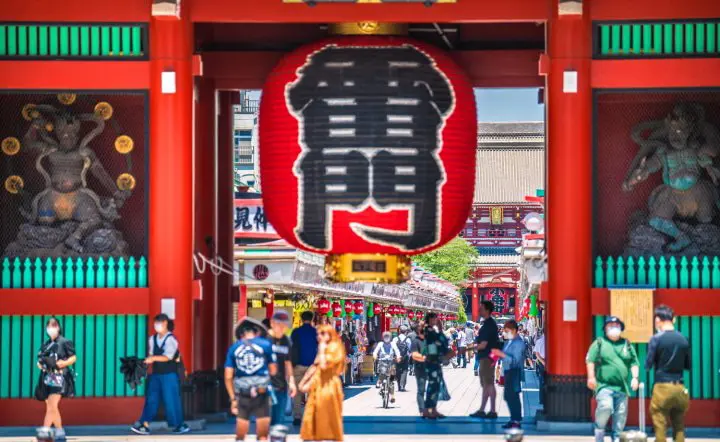
Photo by Pixta
On the right side of Kaminarimon, to the east, you can see a statue of the Wind God, while on the left side, to the west, there is the statue of the Thunder God. These statues are the origin of the name of the Fujin Raijinmon Gate. However, it seems that it was naturally easier to shorten this to the nickname of “Kaminarimon” (“Thunder Gate”).
In this article, we will be introducing some facts about Kaminarimon.
History of the Kaminarimon
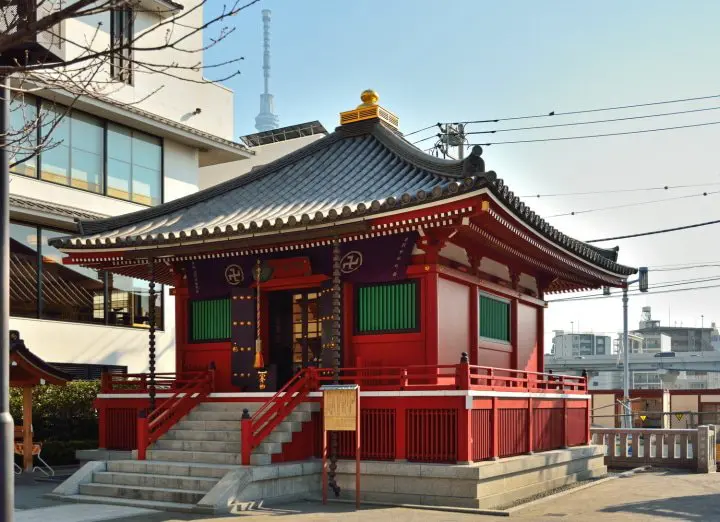
Photo by Pixta
In order to explain the history of Kaminarimon, it’s first necessary to explain a little bit about the history of Sensoji Temple.
The legend says that around the year 628 CE, two brothers fishing in the Sumida River caught a statue of the Bodhisattva Kannon in their net. When the village headman heard about it, he took vows as a Buddhist priest and remade his home into a temple in order to enshrine the statue. This is said to be the beginning of Sensoji Temple. The statue is enshrined in the temple to this very day.
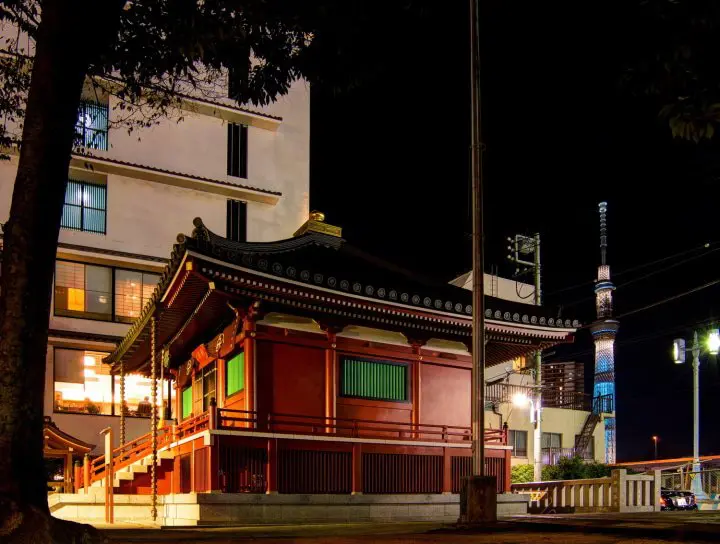
Photo by Pixta
The two photos above show the Komagatado, a prayer hall on the grounds of Sensoji Temple, that was built on the place where it is said that the statue was first discovered. The two sigs shown in the pictures have “Komagata-do” written on them.
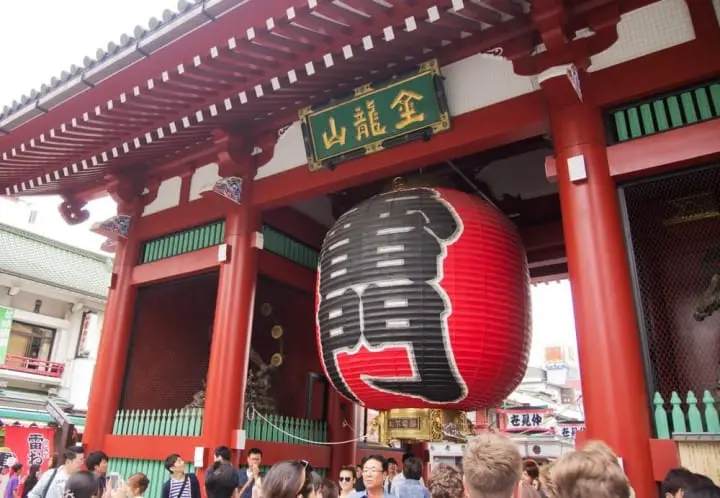
The Kaminarimon Gate itself was built for the first time in 941 by a military commander called Taira no Kinmasa, as a donation to the province of Musashi (the old name of the area corresponding to nowadays' northern Tokyo). The gate has been reconstructed several times after being damaged by fire. The current structure of the gate dates from 1960.
The Giant Lantern of Kaminarimon

The large lantern (called “chochin” in Japanese) found in the center of the Kaminarimon Gate is an iconic symbol of Asakusa. It is 3.9 meters high, 3.3 meters wide, and weighs 700 kilograms.
The framework was created from bamboo harvested in the Tamba region of Kyoto, and the shape was created by wrapping 300 sheets of paper around it. Mulberry products are used for bonding the materials together. This is obtained from Fukui Prefecture, so you could say that this is a completely Japanese-made lantern.
This large lantern is made by a company in Kyoto called Takahashi Lanterns, which is specialized in making traditional chochin. This company has made the lantern within Kaminarimon and has been taking care of its maintenance since 1971, and it seems that they remake the lantern every ten years.
During festival processions, like the Sanja Matsuri, one of the greatest summer festivals held in Asakusa, the lantern is raised, in order for the festival cars to be able to go through the gate. This impressive sight is one of the highlights of the festival!
The Dragon-Shaped Engraving at the Base of the Lantern
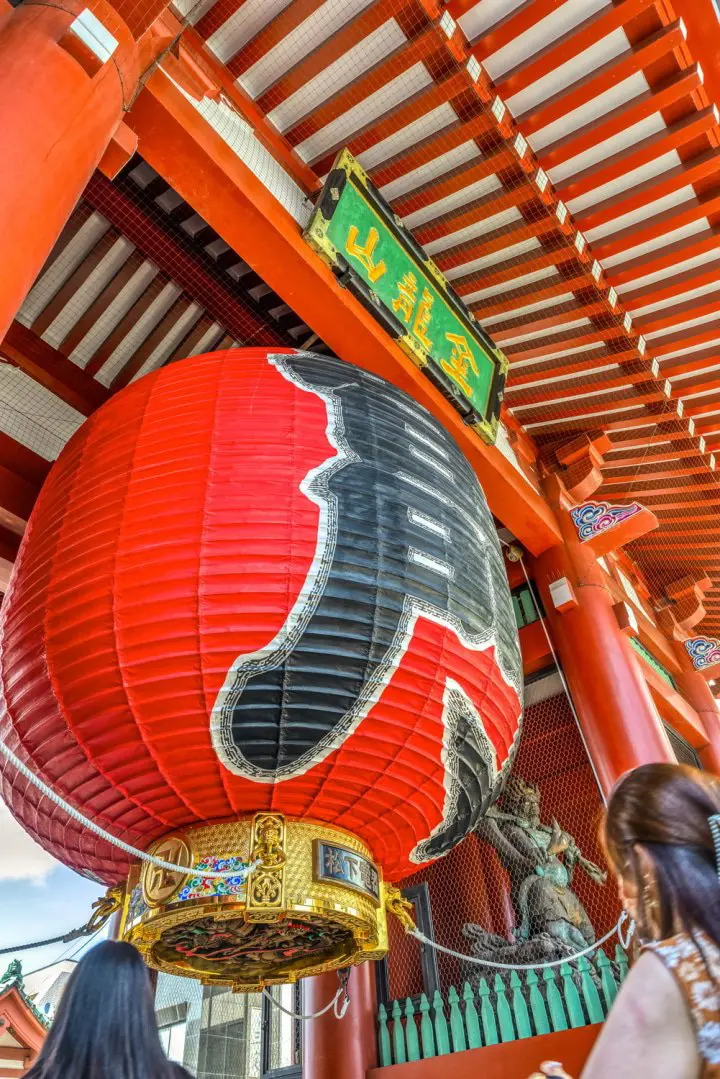
Photo by Pixta
Many travelers coming to Kaminarimon may have noticed a beautiful, detailed dragon-shaped engraving at the bottom of the lantern. It is, in fact, a very meaningful engraving, known as the “Dragon Sculpture”.
Going back to the origin of Sensoiji Temple, legend has it that when the two brothers caught the statue of the Kannon Bodhisattva in their net, a dragon with shining gold scales appeared from the water. Therefore, this dragon carving in the lamp enshrines the dragon as another god watching over the temple.
Also, in Japan, dragons who reside in oceans are said to have power over the clouds and the rain. In the past, Asakusa was a town filled with wooden buildings, flimsy and weak to fire, packed closely together. Being a dragon that lived in water, this dragon was revered as a god that could save Asakusa from fire with its power over water. This is another layer of meaning given to the carving at the bottom of the Thunder Gate lamp.
The Relationship between the Founder of Panasonic and Kaminarimon
The lantern of Kaminarimon has a deep relationship with the Panasonic Corporation. It began all the way back in 1960, when the founder of Panasonic, Konosuke Matsushita, was struck down by disease. He traveled to Sensoji Temple in order to pray for healing. When his disease was successfully cured, he donated the gates and the large lantern as a reward, creating Kaminarimon in the shape we know it today.
That relationship has continued to this day, and if you look around the base of the large lantern, you will see the name “Matsushita Electric Industrial Company” (now known as Panasonic) carved into it.
The Two Statues on the Other Side of Kaminarimon
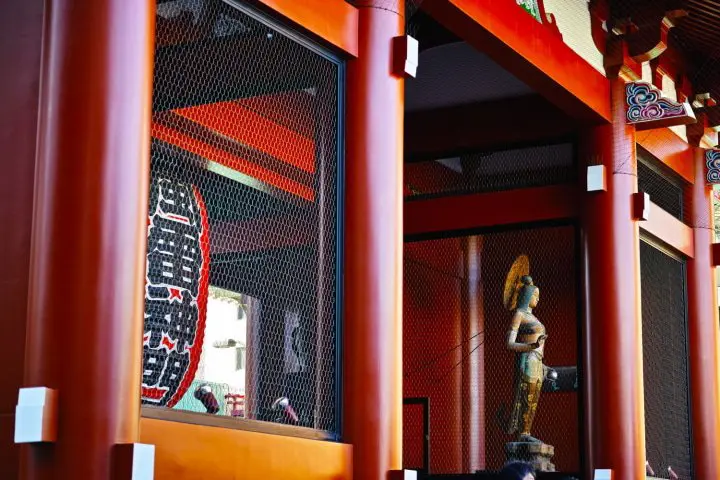
Photo by Pixta
Once you pass under Kaminarimon, you’ll see the two statues on the other side. On the right side, there is the statue of the goddess Kinryu, while on the left-hand side you can see the statue of the god Tenryu.
The meaning of the name “Kinryu” is the “Golden Dragon”, while that of “Tenryu” is “Heavenly Dragon”. Placed in a symmetrical way to Fujin and Raijin, they are also protectors of the Temple and of the Buddhist religion. Dragon gods are meant to both protect people from the raging seas, and to allow crops to grow into a bountiful harvest. At Sensoji Temple, this has led accordingly to the belief that dragon deities are protectors of Buddhism, and based on this belief, these gods are thought of as the protectors of Kaminarimon.
In fact, the full name of Sensoji Temple is Kinryuzan, which means “The Mountain of the Golden Dragon”. This name evokes the image of the two statues within the Kaminarimon, of the Golden and Heavenly dragons. If you look closely, you might notice that each statue quietly sports a dragon tail.
The Surroundings of Kaminarimon
In order to reach Kaminarimon, the entrance to Sensoji Temple, use exit 3 of the Tokyo Metro Ginza Line, or exit A5 of the Toei Subway Asakusa line. The large avenue you will see when reaching the surface is called Kaminarimon-dori (Kaminarimon Avenue). It is a busy street, bustling with the activity of the local small businesses, as well as with larger buildings and institutions.
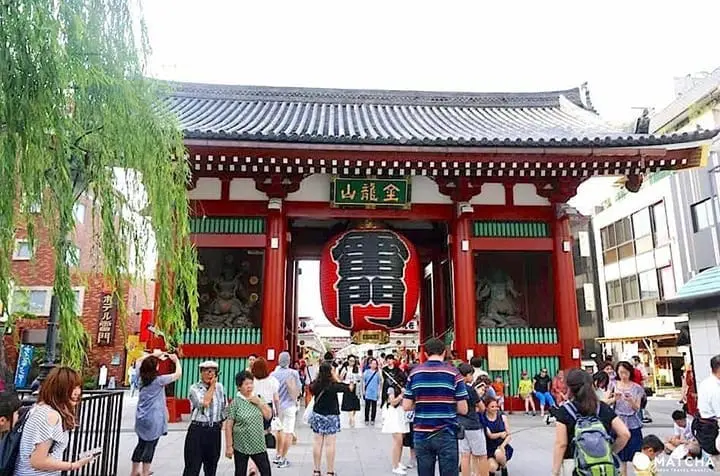
Around the Kaminarimon Gate, at any time of the year and of the day, you will find many domestic and international travelers taking pictures of the impressive gate and its lantern. In order to take the best shot of Kaminarimon, please wait for your turn to take pictures posing under the lantern.

After you pass through the gate heading toward the main hall of Sensoji Temple, you will enter a bustling street lined with souvenir shops. This is the famous Nakamise-dori, which connects Kaminarimon, the entrance gate to Sensoji, with the temple grounds. While here, do look around for souvenirs of your visit to Sensoji. There is no place like the Nakamise-dori when it comes to souvenirs from Japan!
Take a Good Look at Kaminarimon when Visiting Asakusa
We hope that this information on Kaminarimon Gate and the beautiful Sensoji Temple will help you enjoy your visit even more. Every detail of the Kaminarimon Gate is significant, and each statue and lantern within the temple grounds have their own unique history.
If you visit Kaminarimon, try to both look for these details and enjoy the whole picture. Your visit will most likely be a very enjoyable experience!
Sensoji Temple, Asakura Kaminarimon
Address: Tokyo, Taito ward, Asakusa 2-3-1
Nearest station: Asakusa Station on the Tokyo Metro Ginza line, Tōbu Skytree Line, or Toei Subway Asakusa Line.
Access: 5-minute walk from Asakusa Station (Exit 3) of Tokyo Metro Ginza Line, or of the Tobu Skytree Line or Tsukuba Express. A 7-minute walk from Asakusa Station (Exit A5) of the Toei Subway Asakusa Line.
Price range: free.
Religion: Buddhism
Phone number: +81-3-3842-0181
Official Website: Sensoji Temple
Hello, I'm Keisuke. living Asakusa Tokyo Japan. Love triathlon(Ironman), traveling, reading, eating and my job. I really really like Japan but I think Japan should be more kindly to traveler. https://www.facebook.com/keisukeyamada84








































![[Coupon Available] Attention Overseas Winter Sports Fans! Nagano's Sports Depot Has Evolved](https://resources.matcha-jp.com/resize/720x2000/2026/01/05-254819.webp)
![[2 hours from Tokyo ] 10 Quiet and Breathtaking Views of Mount Fuji in Yamanashi Hokuto City , Yamanashi - Part 2](https://resources.matcha-jp.com/resize/720x2000/2025/12/16-253037.webp)

![[Reopening in March 2026] Ikoma Sanjo Amusement Park Park, 45 minutes from Osaka , with free admission](https://resources.matcha-jp.com/resize/720x2000/2024/08/28-194409.webp)
![[Gunma] 5 recommended gourmet foods at Kawaba Denen Plaza Roadside Station!](https://resources.matcha-jp.com/resize/720x2000/2025/02/26-225970.webp)